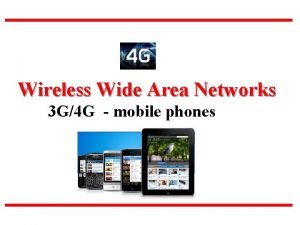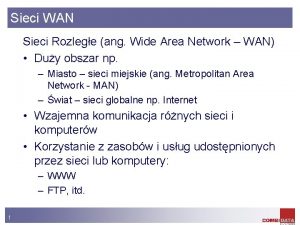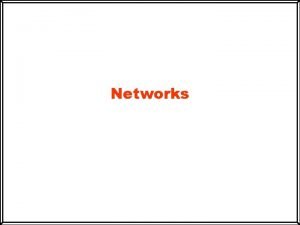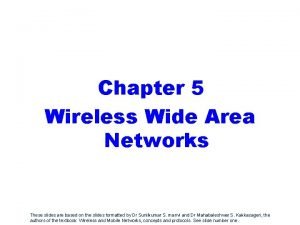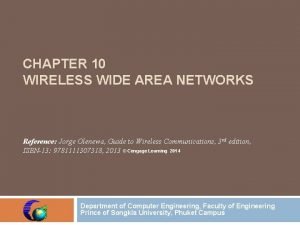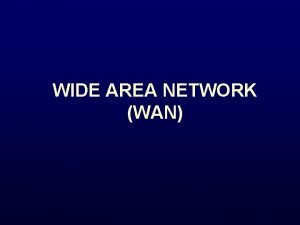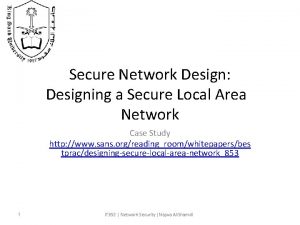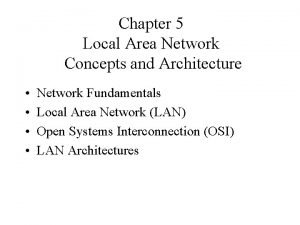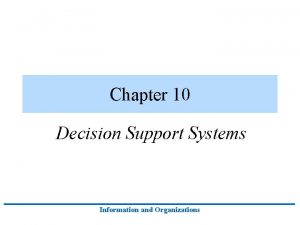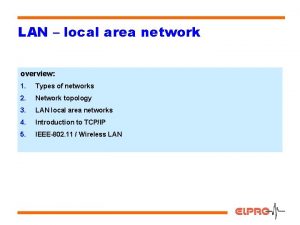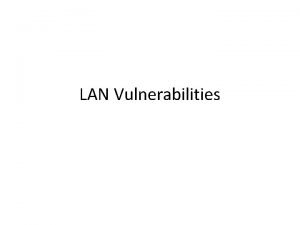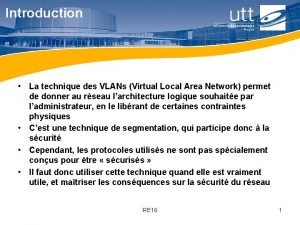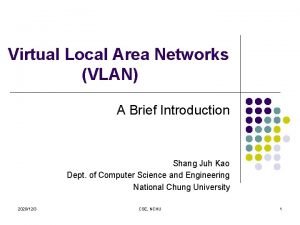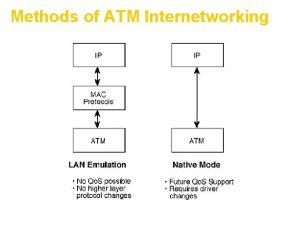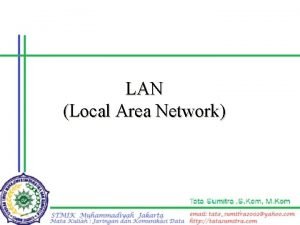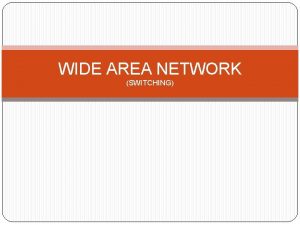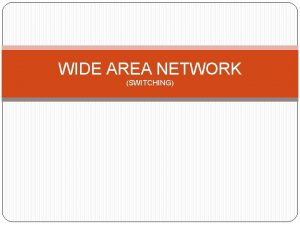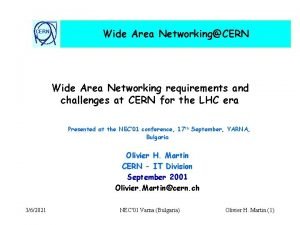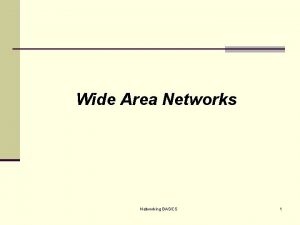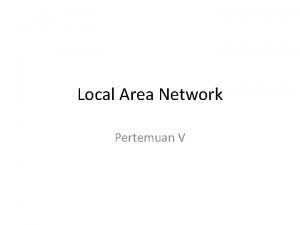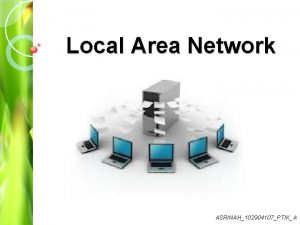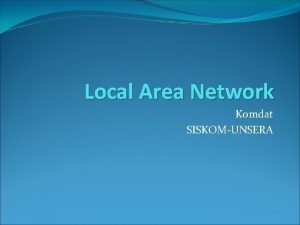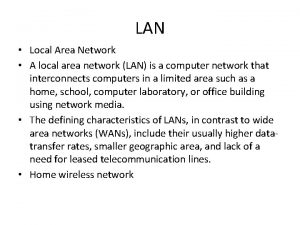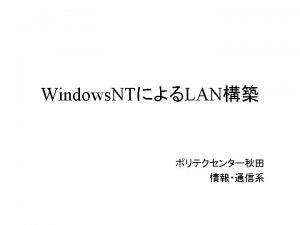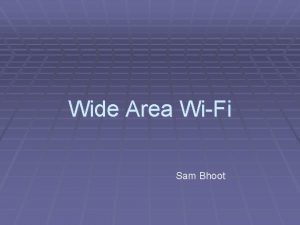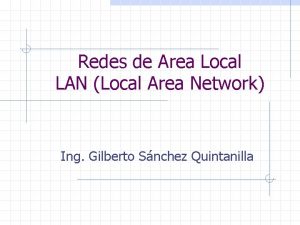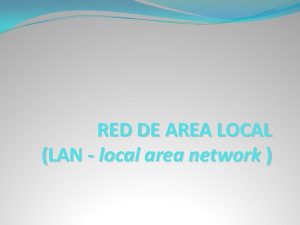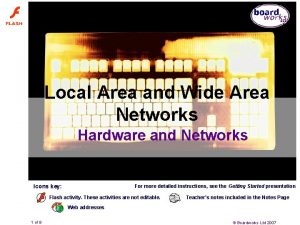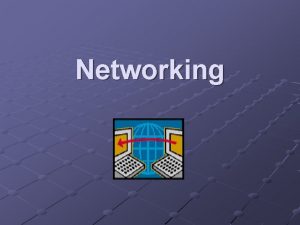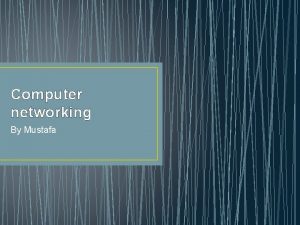Internet Networking Local area network Wide area network



















- Slides: 19

Internet , Networking, Local area network, Wide area network, Configurations

1. 1 Data communication system Definition • Data communication refers to the exchange of data between a source and a receiver via form of transmission media such as a wire cable. Data communication is said to be local if communicating devices are in the same building or a similarly restricted geographical area. OR • Data communications (DC) is the process of using computing and communication technologies to transfer data from one place to another, and vice versa. It enables the movement of electronic or digital data between two or more nodes, regardless of geographical location, technological medium or data contents.

Explanation • Data communications incorporates several techniques and technologies with the primary objective of enabling any form of electronic communication. These technologies include telecommunications, computer networking and radio/satellite communication. Data communication usually requires existence of a transportation or communication medium between the nodes wanting to communicate with each other, such as copper wire, fiber optic cables or wireless signals. • For example, a common example of data communications is a computer connected to the Internet via a Wi-Fi connection, which uses a wireless medium to send and receive data from one or more remote servers. • Some devices/technologies used in data communications are known as data communication equipment (DCE) and data terminal equipment (DTE). DCE is used at the sending node, and DTE is used at the receiving node

1. 2 Basic Components of a data communication system • There are five basic component of data communication system • • • Message Sender Receiver Transmission medium Protocol

Components of data communication system 1. 2. 1 Message: It is the information to be communicated. Popular forms of information include text, picture, audio, video etc. Text is converted to binary, number does not converted, image is converted to pixel. 1. 2. 2. Sender It is the device which send the data messge. It can be a computer, workstation, telephone handset etc. 1. 2. 3 Receiver It is the device which receives the data messages. It can be a computer, workstation, telephone handset etc. 1. 2. 4 Transmission Medium It is the physical path by which a message travels from sender to receiver. Some examples are twisted pair wire, coaxial cable, radio waves etc 1. 2. 5 Protocol It is the set of rules that governs data communication. It represent an agreement betweem the communication devices. Without a protocol, two devices may be connected but not communicate.

1. 3 Data transmission modes • Transmission mode refers to the mechanism of transferring of data between two devices connected over a network. It is also called Communication Mode. These modes direct the direction of flow of information between two devices • There are three types of transmission mode • Simplex, half duplex, and full duplex

Simplex • In simplex transmission mode, the communication between sender and receiver occurs in only one direction. The sender can only send the dta, and the receiver can only receive the data. The receiver cannot reply to the sender. • Simplex transmission can be thought of as a one-way road in which the traffic travels only in one direction—no vehicle coming from the opposite direction is allowed to drive through. • To take a keyboard / monitor relationship as an example, the keyboard can only send the input to the monitor, and the monitor can only receive the input and display it on the screen. The monitor cannot reply, or send any feedback, to the keyboard.

Half Duplex • The communication between sender and receiver occurs in both directions in half duplex transmission, but only one at a time. The sender and receiver can both send and receive the information, but only one is allowed to send at any given time. Half duplex is still considered a one-way road, in which a vehicle traveling in the opposite direction of the traffic has to wait till the road is empty before it can pass through. • For example, in walkie-talkies, the speakers at both ends can speak, but they have to speak one by one. They cannot speak simultaneously.

Full Duplex • In full duplex transmission mode, the communication between sender and receiver can occur simultaneously. The sender and receiver can both transmit and receive at the same time. Full duplex transmission mode is like a two-way road, in which traffic can flow in both directions at the same time. • For example, in a telephone conversation, two people communicate, and both are free to speak and listen at the same time.

Key Differences of the Three Transmission Modes Basis for Comparison Simplex Half Duplex Full Duplex Unidirectional Two-directional, one at a time Two-directional, simultaneously Send / Receive Sender can only send data Sender can send and receive data, but one a time Sender can send and receive data simultaneously Performance Worst performing mode of transmission Better than Simplex Best performing mode of transmission Example Keyboard and monitor Walkie-talkie Telephone Direction Communication of

1. 4 Data transmission speed • The speed with which data can be transmitted from one device to another. Another term for data transfer rate is throughput. • Data rates are often measured in megabits (million bits) per second (abbreviated as Mbps) • or megabytes (million bytes) per second abbreviated as MBps.

Data transmission media • In data communication terminology, a transmission medium is a physical path between the transmitter and the receiver. It is the channel through which data is sent from one place to another.

Guided Media • It is also referred to as Wired or Bounded transmission media. Signals being transmitted are directed and confined in a narrow pathway by using physical links. • Features: • High Speed • Secure • Used for comparatively shorter distances

Unguided Media • It is also referred to as Wireless or Unbounded transmission media. No physical medium is required for the transmission of electromagnetic signals. • Features: • Signal is broadcasted through air • Less Secure • Used for larger distances

Digital and Analog transmission • Analog transmission is a method of conveying voice, data, image, signal, or video information. It uses a continuous signal varying in amplitude, phase, or another property that is in proportion to a specific characteristic of a variable. Digital transmission or digital communications is a literal transfer of data over a point to point (or point to multipoint) transmission medium –such as copper wires, optical fibres, wireless communications media, or storage media. The data that is to be transferred is often represented as an electro-magnetic signal (such as a microwave). Digital transmission transfers messages discretely.

Modems • Short for modulator-demodulator • A modem is typically used to send digital data over a phone line. The sending modem modulates the data into a signal that is compatible with the phone line, and the receiving modem demodulates the signal back into digital data. Wireless modems convert digital data into radio signals and back.

Routing techniques • Routing is the process of selecting a path for traffic in a network or between or across multiple networks. . Packet forwarding is the transit of network packets from one network interface to another. Intermediate nodes are typically network hardware devices such as routers, gateways, firewalls, or switches. • Source routing • In computer networking, source routing, also called path addressing, allows a sender of a packet to partially or completely specify the route the packet takes through the network. It contains information from source to destination along with path it should follow. • Hop-by-hop routing means that routing decisions are made at each router independently and locally. The hop-count shortest-path routing (SP) is the most commonly used method for IP routing in today's Internet.

Types of connections • Point to point connection In telecommunications, a point-to-point connection refers to a communications connection between two communication endpoints or nodes. . This is contrasted with a point-to-multipoint or broadcast connection, in which many nodes can receive information transmitted by one node. • Multi point connection A multipoint connection is a link between three or more devices. It is also known as Multi-drop configuration. The networks having multipoint configuration are called Broadcast Networks. In broadcast network, a message or a packet sent by any machine is received by all other machines in a network.

BASIS FOR COMPARISON POINT-TO-POINT MULTIPOINT Link There is dedicated link between two devices. The link is shared between more than two devices. Channel Capacity The channel's entire capacity is reserved for the two The channel's capacity is shared temporarily connected devices connected to the link. Transmitter and Receiver There is a single transmitter and a single receiver. There is a single transmitter and multiple receivers. Example Frame relay, T-carrier, X. 25, etc. Frame relay, token ring, Ethernet, ATM, etc. among the
 Sdn overview
Sdn overview Very wide shoot
Very wide shoot Mobile wide area network
Mobile wide area network Wan wide area network
Wan wide area network Local area network topology
Local area network topology Wireless wide area network
Wireless wide area network Wide area network example
Wide area network example Wireless wide area network
Wireless wide area network Wide area network wan fort myers
Wide area network wan fort myers Wide area network adalah
Wide area network adalah Internet way of networking
Internet way of networking Design a secure network
Design a secure network Local area network architecture
Local area network architecture Disadvantages of decision support system
Disadvantages of decision support system Lan type a
Lan type a Lan vulnerabilities
Lan vulnerabilities Vlan (virtual local area network)
Vlan (virtual local area network) Introduction of vlan
Introduction of vlan Lan
Lan Sebutkan karakteristik dari jaringan lan
Sebutkan karakteristik dari jaringan lan


